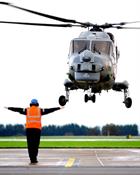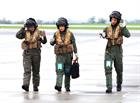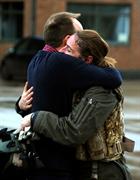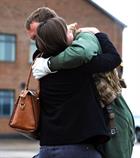Lynx flight return to base after nine month deployment to the Middle East
Lynx Flight 219 has returned to base at Royal Naval Air Station (RNAS) Yeovilton following the first 9 month deployment to be completed in the Royal Navy in recent times.
Flight Commander Lieutenant (Lt) Sally Lawrence-Archer (36) deployed from 815 Naval Air Squadron (NAS) with her Flight on 2 March 2015 for 9 month embarked in HMS Duncan to the Middle East.
The Lynx Mk8 helicopter played a key role in the deployment, monitoring hundreds of square miles for small vessels by day and night.
Lt Lawrence-Archer said: “Being away for 9 months is quite a long time and brings with it many challenges. We deployed on Op Kipion and participated in many exercises with various Middle Eastern nations.
"For long periods we were attached to the American carrier task group and acted as the primary Air Defence Destroyer for the USS Franklin Roosevelt, the first Royal Navy ship to do so.”
The Royal Navy’s newest warship returns to Portsmouth today Friday 27 November. The Type 45 destroyer HMS Duncan has sailed 43,000 nautical miles and visited 14 countries.
Being away for 9 months is quite a long time and brings with it many challenges. We deployed on Op Kipion and participated in many exercises with various Middle Eastern nations.
Lt Lawrence-Archer
Duncan has policed busy shipping lanes in seven different seas and two oceans and provided protection for the US Navy aircraft carrier USS Theodore Roosevelt during air strikes against ISIL. Working with the carrier in the northern Gulf, Duncan used her state-of-the-art Samson radar to monitor air traffic.
Commander Richard Atkinson, HMS Duncan’s commanding officer, said: “I am immensely proud of the work HMS Duncan’s 240 sailors and marines have completed over these nine months away from the UK.”
The Ship primarily worked to provide surface and air defence to the aircraft carrier USS Theodore Roosevelt while she conducted day and night strikes against ISIL.
As Britain’s newest warship, a formidable Type 45 air defence destroyer, our very presence in the Gulf, off Yemen or in the Black Sea, showed the ongoing commitment of the Royal Navy in maintaining safety, security and freedom of navigation at sea.
Working and training alongside Gulf navies and coastguards and with NATO allies, demonstrated readiness to deal with any incidents, from helping injured fisherman at sea to the more challenging air defence and surveillance tasks associated with a complex and occasionally volatile region.
The ship also hosted one of the Royal Navy’s new Wildcat helicopters also based at RNAS Yeovilton on 825 NAS for hot-weather trials in the hot, humid conditions of the Gulf.
Pilot Lt Lee Holborn (28) who achieved his 1000th flying hour as he landed back at Yeovilton said “this is the first time I have flown with a US Navy Carrier and it has been a great experience. I am however very glad to be home.”
Lt Holborn’s girlfriend Miss Alice Nolan (28) was there to meet him after 9 long months. She said “it has been really strange to not have Lee around for such a long time; he has missed many birthdays and weddings that I have attended without him.
"Its great to have him back and we can now return to the more normal things in life. We will continue house hunting which has been on hold for the last 9 months!”
During Duncan’s 9 month deployment the logistics department were kept very busy keeping the ship topped up with essentials. The ship’s company have used or consumed:
- Enough toilet roll to wrap around the 150-metre long ship over 3,000 times
- 12,000 eggs
- 16 tonnes of potatoes
- 13,000 apples
- Enough diesel fuel to drive a Ford Mondeo around the world 5,000 times!






